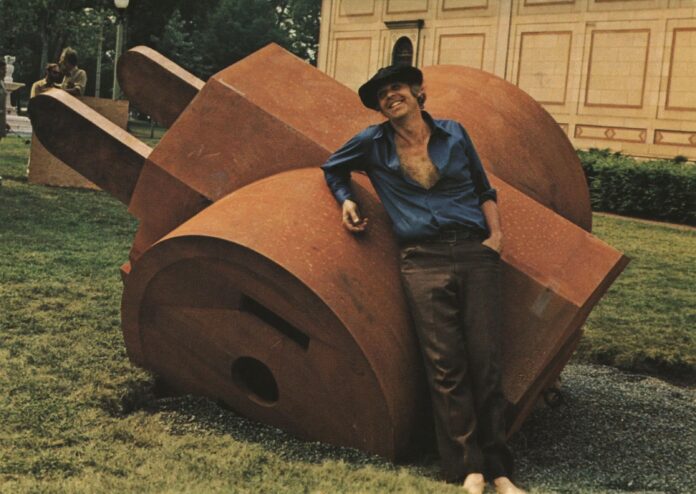Claes Oldenburg, one of the key figures of Pop Art and a seminal personality in post-war American art, has died, aged 93. He was recovering after suffering a fall when he died in his home and studio in Manhattan’s SoHo neighbourhood.
Oldenburg was born in Stockholm, Sweden on 28 January, 1929. His mother Sigrid Elisabeth Oldenburg was a concert singer and his father Gosta Oldenburg was a Swedish diplomat—a role that required the family to frequently relocate throughout the world. In 1936, the family moved to Chicago, where they remained for the rest of Claes’s childhood.
From 1946 to 1950, Oldenburg studied English and Art History at Yale, after which he returned to study at the Art Institute of Chicago. In 1956, Oldenburg moved to New York City, where he quickly became involved in Happenings, a term coined by Allen Kaprow—whom Oldenburg befriended soon after his arrival in the city—to describe a newly popular type of participatory performance art.
In 1959, Oldenburg’s first ever solo-exhibition was held at the Judson Gallery, a space in the basement of the Judson Memorial Church in Greenwich Village that was, among other things, the birthplace of the Judson Dance Theater. The show included collage, drawings and paper-mache sculpture. In 1961, Oldenburg embarked on a project called The Store, in which he rented a storefront at 107 East 2nd Street in Lower Manhattan out of which he made and sold art. The sculptures themselves were drippy, loose renditions of quotidian objects such as food, clothing and furniture that combined the conceptual sensibilities of Pop Art with the aesthetic signifiers of Abstract Expressionism.
“The one rule of my work is that it must not have any function,” Oldenburg told MoMA in an interview about The Store. “I begin by removing the function of the thing because it’s true function is to become an artwork.”
In selling his own work directly from the space of its conception, Oldenburg was also making a statement about the art market, both about one’s potential circumnavigation of the traditional gallery model and about art-as-commodity. For the second version of the store, Oldenburg, along with his first wife Patricia Muschinski, known as Patty Mucha, stocked the shop with massive ‘soft’ objects such as a 10 ft-long ice cream cone and a 5-by-7-foot hamburger made from sewn and stuffed fabric. This was an early look into what would become key traits to two of Oldenburg’s bodies of work: an interest in scale, which would quickly take off to new heights, and an interest in soft sculpture, of which the artist made hundreds.
In 1969, Oldenburg was commissioned by a group of Yale architecture students to create Lipstick (Ascending) on Caterpillar Tracks, the first of many “Colossal Monuments”, as he called them. Lipstick consisted of a 24 ft-tall inflatable lipstick tube mounted on what resembled tank treads. Dual nods to both the women’s liberation movement and the student-led protests against the Vietnam War, the work was displayed prominently on the Yale campus. It was remade in steel five years later, and it remains on the New Haven campus today.
Oldenburg and Mucha divorced in 1970, and later that same decade he met art historian Coosje van Bruggen. The two married in 1977 and became lifelong creative partners, collaborating on works until Bruggen’s death in 2009. One year before their wedding, Oldenburg and van Bruggen collaborated on their first work together: the 1976 sculpture Trowel I, a 38 ft-tall gardening spade installed at the Kröller-Müller Museum in the Dutch city of Otterlo. The two worked on over 40 commissions together, including a clothespin in Philadelphia, a shuttlecock in Kansas City, a rubber stamp in Cleveland and scores more in a similar vein, all at a gargantuan scale.
In some instances, the connection between the site and the content of the work were unclear, while others—like Lipstick—contained more explicit political commentary. Oldenburg also conceived of a number of sharply political public works that were never realized; these include replacing the Statue of Liberty with a massive electric fan to symbolize the United State’s desire to blow immigrants away from its shores, and replacing the Washington Monument with a pair of scissors. “Like the scissors, the U.S.A. is screwed together,” he wrote, “two violent parts destined in their arc to meet as one.”
“The loss of Claes Oldenburg, a great artist and good friend, is deeply saddening,” wrote Paula Cooper, Oldenburg’s longtime friend and gallerist for the past 20 years. “The strikingly original early work was hugely influential on many artists, who were informed by his freedom of thought and radical mode of expression. When he began his collaboration with Coosje van Bruggen, with whom I had a close friendship, the work became grander and bolder. It was thrilling to work with Claes, whose odd take on things was delightful, and could completely turn one’s mood around.”

























